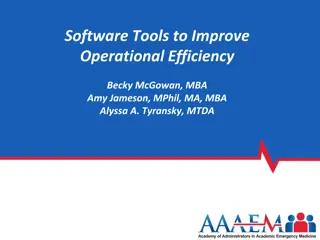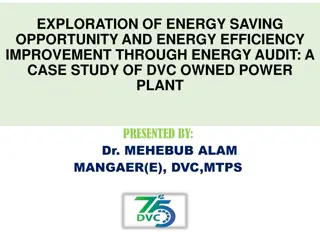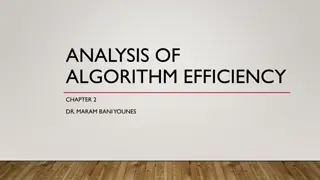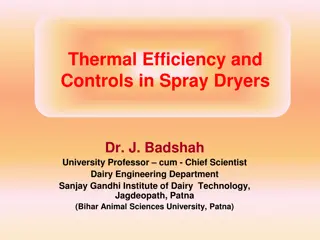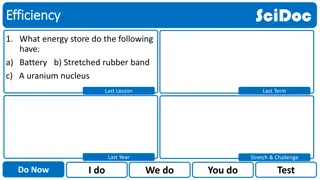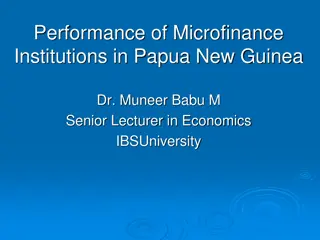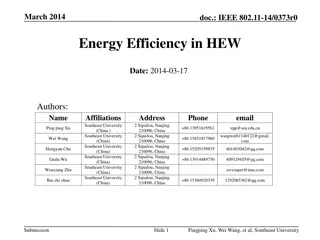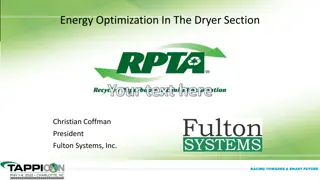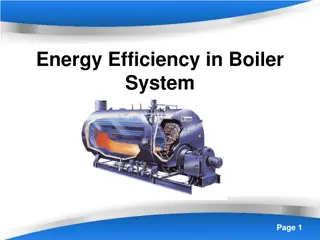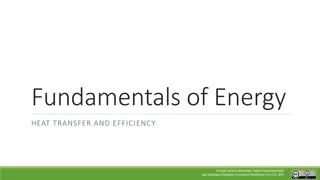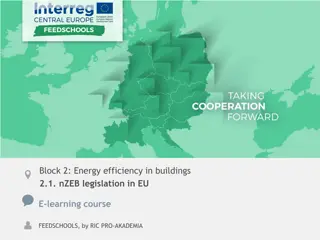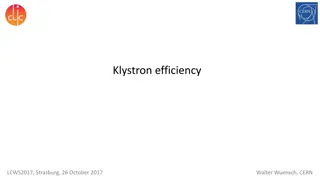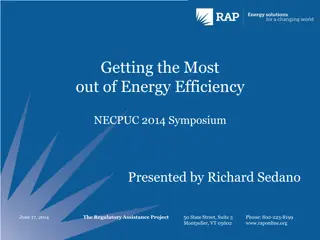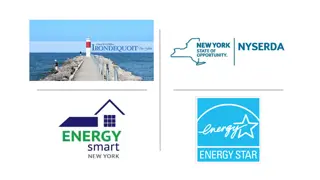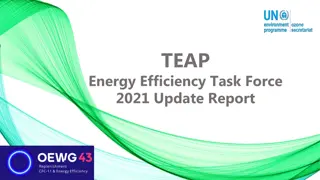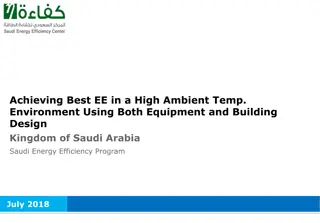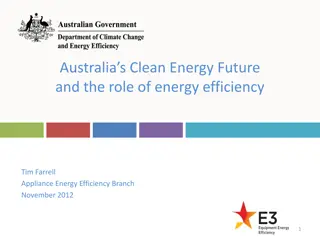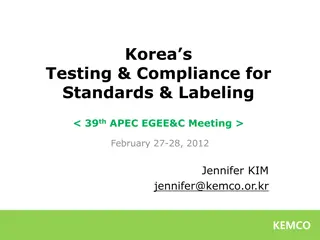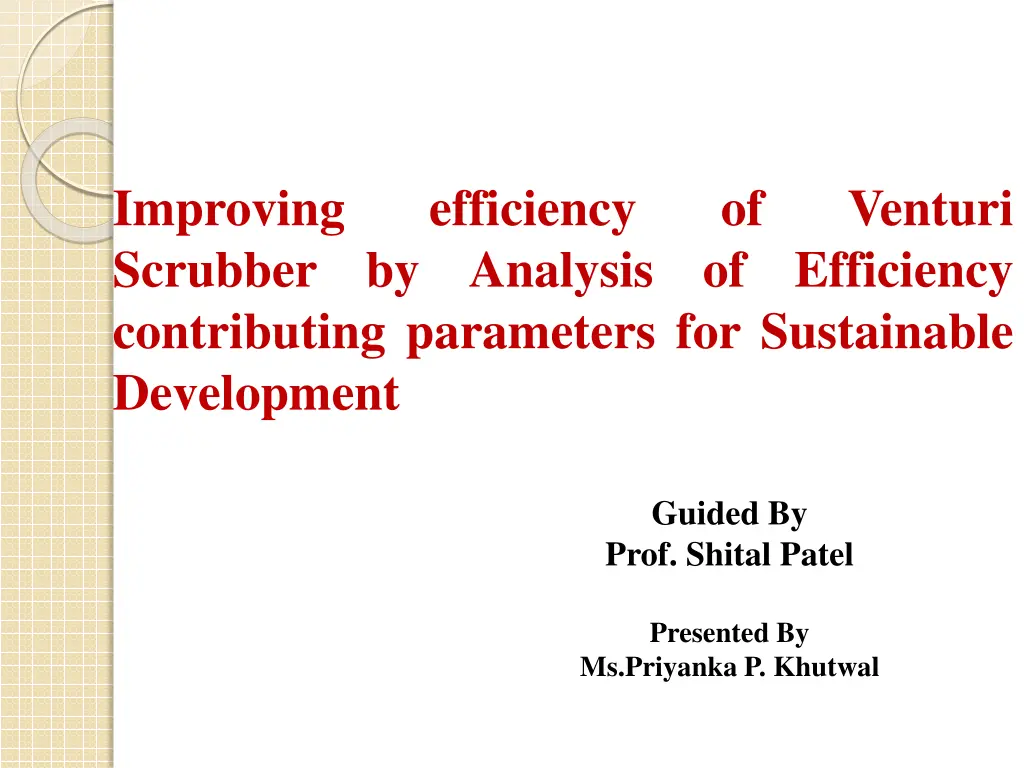
Efficiency Analysis of Venturi Scrubber for Sustainable Development
"Explore the efficiency of Venturi scrubbers for sustainable development through the analysis of contributing parameters. Understand the working principles, experimental setup, and maintenance impact on scrubber efficiency."
Download Presentation

Please find below an Image/Link to download the presentation.
The content on the website is provided AS IS for your information and personal use only. It may not be sold, licensed, or shared on other websites without obtaining consent from the author. If you encounter any issues during the download, it is possible that the publisher has removed the file from their server.
You are allowed to download the files provided on this website for personal or commercial use, subject to the condition that they are used lawfully. All files are the property of their respective owners.
The content on the website is provided AS IS for your information and personal use only. It may not be sold, licensed, or shared on other websites without obtaining consent from the author.
E N D
Presentation Transcript
Improving Scrubber by Analysis of Efficiency contributing parameters for Sustainable Development efficiency of Venturi Guided By Prof. Shital Patel Presented By Ms.Priyanka P. Khutwal
Contains Introduction Objective Problem statement Literature survey Methodology References
Introduction Sustainable development is development that meets the needs of the present without compromising the ability of future generations to meet their own needs The overall air problem basically includes the forms such as , emissions, transport, dilution, and modification in the atmosphere, which effects on people, property, and the environment. We are unlikely to find a good and easy way to solve all these problems. Doing some research on particulate removal from gaseous waste streams so that improve the air quality.
Cont.. So many method are available for the pollution monitoring for the industry like, separation techniques, gas solid separation, liquid-liquid separation, gas liquid separation. In case of gas solid separation technique cyclone separator, multi clone, electrostatic precipitator, scrubber and fabric filter including ceramic filter pollution monitoring equipment are used
Cont.. Among all techniques gas solid separator and the equipment venturi scrubber is the best one. The venturi scrubber is a device which uses liquid in the form of droplets to efficiently remove fine particulate matter from gaseous streams
Cont.. A venturi scrubber consists of a converging section, a throat (the narrowest part of the venture tube) and a diffuser. The dust/gas mix flows through the venturi tube and reaches top speed in the throat section. Thereafter, the mixture passes into the diffuser where the speed drops again. Liquid is added to the gas flow either in the throat section or prior to it. Intensive mixing takes place between the gas and the liquid in the throat section of the venture tube. Due to the high speed realised by the gas and liquid, water is
Objective The objective of this research is to study the working of venturi scrubber To analyze overall experimental setup To finding out how the maintenance of venturi scrubber affect on their efficiency To study the effect of parameter on venturi scrubber efficiency(separation efficiency of 80%) in industry To increase the venturi scrubber efficiency There by improving the life cycle
Parameter Affecting Parameters Liquid flow rate Throat gas velocity Affect on efficiency Increases with amount of liquid Increases with velocity
Problem Statement This project is about to Improving efficiency of venturi scrubber by Analysis of Efficiency contributing parameters to enhance its product life cycle which solve the air pollution problems (effects to people's health) by blowing away the poisonous air and the particles in the air
Introduction Basic foundry processes vary only slightly from one foundry to another All foundry operations Produce castings by pouring molten metal into molds, often consisting of molding sand and core sand. Once the casting has hardened, it is separated from the molding and core materials in the shakeout process. The castings are cleaned, inspected, and then shipped for delivery
Cont.. Data is collected from 3 different foundries (foundry (F1),foundry (F2), foundry (F3). These foundries produces castings by sand castings All these foundries are ferrous in nature .waste measurement is carried out with the help of XYZ Enviro Care Private. Ltd at Vatva. The purpose of taking help of XYZ Enviro Care Private. Ltd Vatva is to have an accurate and precise reading so that real interpretation can be made. Data is compared with the standards of CPCB (Central pollution control board) and MOEF (Ministry of environment and forests).
Materials inputs and potential pollutant outputs for foundry 1 Pattern Making In pattern making process, material inputs may be wood, plastic, metal, wax, polystyrene Pollutants outputs given below. Air Emissions: VOC (Volatile Organic Compound) from glues, epoxies, and paints. Waste water: Little or no wastewater generated but there is no plan for water utilization. Residual Wastes: Scrap pattern materials
Cont.. 2 Mold and Core Preparation and Pouring In this process, materials inputs may be sand and chemical binders and pollutants outputs Air Emissions: Particulates, metal oxide fumes, carbon monoxide, hydrogen sulfide, sulfur dioxide, and nitrous oxide. Also, Benzene, phenols, and other hazardous air pollutants Wastewater: Wastewater containing metals, elevated temperature, phenols and other organics from wet dust collection systems and mold cooling water Residual Wastes: Waste mold and core sand potentially containing metals and residual chemical binders
Cont.. 3Charging and Melting In charging and melting process, material inputs may be metal scrap, ingot and returned castings and pollutant outputs given below. Air Emissions: Products of combustion, oil vapors, particulates, metallic oxide fumes Wastewater: Scrubber wastewater with high pH, slag cooling water with metals, and non- contact cooling water Residual Wastes: Spent refractory material potentially containing metals and alloys
Cont.. 4 Pouring In this process, material inputs ladles and refractory materials and pollutant outputs given below. Air Emissions: Particulates, metallic oxide fumes Wastewater: Little or no wastewater generated Residual Wastes: Spent ladles and refractory materials potentially containing metals
Cont.. 5 Shakeout, Cooling and Sand Handling In this process, material inputs may be water and caustic for wet scrubbers and pollutant output given below. Air Emissions: Dust and metallic particulates; VOC and organic compounds from thermal sand treatment systems. Wastewater: Wet scrubber wastewater with high or low pH or amines, permanent mold contact cooling water with elevated temperature, metals and mold coating Residual Wastes: Waste foundry sand and dust from collection systems, metal
Cont.. 6 Felting In this process, material inputs may be unfinished castings, water, steel shot, and solvents. Pollutant outputs given below. Air Emissions: VOCs, dust and metallic particulates Wastewater: Waste cleaning and cooling water with elevated temperature, solvents, oil and grease, and Suspended solids Residual Wastes: Spent solvents, steel shot, metallic particulates, cutting wheels, metallic filings, dust from collection systems, and wastewater treatment sludge.
Survey In India there are more than 5000 foundries There are many hubs of foundries like West Bengal, Gujarat, Maharashtra, Tamilnadu, Karnataka, Andra Pradesh and Jharkhand. Ahmadabad, located in the state of Gujarat, is an important foundry cluster in Western India There are about 600 foundry units in Gujarat. The cluster came-up mainly to cater to the casting requirements of the local diesel engine industry To have true picture of these hubs, foundries from Ahmadabad were chosen for study of investigation of wastes
Experimental result of solid waste Sr. No . Waste Concentration in mg/kg cu zn Pb Ni F1 F2 F3 F1 F2 F3 F1 F2 F3 F1 F2 F3 1 Sand waste 220 190 182 79 71 67 172 180 158 125 130 118 2 Dust 166 143 151 169 138 149 263 255 248 206 199 224 3 Slag waste 520 482 543 306 297 319 49 52 57 484 490 503 4 Waste From Ladle 141 130 150 340 312 302 30 26 23 239 227 244
Conclusion of survey From table following conclusion can be made 1. The foundries generate lot of Solid waste like sand waste, dust, and slag waste, waste from ladle which is harmful for human health. There is no arrangement for beneficial reuse, disposal, treatment and handling 2. Regarding air emission, Small and medium size foundries from Ahmadabad hub are emitting pollutants from different department namely Furnace operation, Preparation of cores and molds, Casting, Shakeout and reclamation.
Scope of survey There is a tremendous scope for these foundries to use the high quality raw material for reduce the harmful materials and particulars in the air and the devices like Filters, Cyclones separators, Mechanical Collectors, Scrubbers to enhance the awareness in relation with cleaner production idea There is a lack of economical information for many recent techniques. There is need of awareness with this regard towards moving for sustainable development.
Methodology Generally different models are available for the calculation of Venturi particle collection efficiency. Johnstone equation, Infinite throat mode, Cut power method, Contact power theory, Pressure drop. Johnstone method One of the more popular and widely used collection efficiency equations is that
Cont.. =is the collection efficiency, Kp = is the inertial impaction parameter (dimensionless), R= liquid-to-gas ratio k =the correlation coefficient, The inertial impaction parameter (Kp) given by Equation where dp =the particle diameter (ft), p = the particle density (lb/ft3), Vt=the throat velocity (ft/s), G= the gas viscosity (lb/ft-s =the mean droplet diameter (ft) and C = the Cunningham correction factor(dimensionless).
Cont.. The mean droplet diameter (dd) for standard air and water in a venturi scrubber is given by the Nukiyama- Tanasawa relationship, shown in Equation . The overall collection efficiency of the system can be calculated using Equation where Mdis the weight percent of the particles of a given diameter.
Cont.. How the parameters affects on venturi scrubber efficiency by using ANSYS Software
About Company EG Tech corporation: EG Tech has been managing POSCO's Acid Recycling Facility They are make Iron Oxide(Fe2O3) powder
REFERENCE [1] Azzopardi B.J. and A.H. Govan (1984), The modeling of Venturi scrubbers Filtration and Separation, Vol. 23, pp. 196-200. [2] Azzopardi B.J., S.F.C.F. Teixeira, A.H. Govan and T.R. Bott (1991) An improved model for pressure drop in Venturi scrubbers , Transactions of the Institute of Chemical Engineers, B69, pp. 55 64. [3] Boll R.H. (1973) Particle collection and pressure drop in Venturi scrubbers Industrial Fundamentals, Vol. 12(1), 40-50. [4] Calvert S., (1970) Venturi and other atomizing scrubbers efficiency and pressure drop , AIChE Journal, Vol. 16, pp. 392-396. [5] Calvert S., D. Lundgren and D.S. Mehta (1972) Venturi scrubber performance Journal of Air Pollution Control Association, Vol. 22, pp. 529-532. & Engineering Chemistry
REFERENCE [6] Charisiou N.D., G. Tsevrenis, M.A. Goula (2011) Software development for the design of control equipment for particulate pollutants , Proc. Int. Conf. on Environmental Science and Technology VII, pp. A295-A302. [7] Goncalves J.A.S., D. Fernandez Alonso, M.A. Martins Costa, B.J. Azzopardi and J.R. Coury (2001) Evaluation of the models available for the prediction of pressure drop in Venturi scrubbers Journal of Hazardous Materials, Vol. B81, pp. 123-140. [8] Goncalves J.A.S., M.A.M. Costa, M.L. Aguiar and J.R. Coury (2004) Atomizatin of liquids in a Pease Anthony Venturi scrubber. Part II. Droplet dispersion Journal of Materials, Vol. 116, pp. 147- 157. [9] Cooper C.D. and F.C. Alley (2004) Air pollution control: A design approach Waveland Press, Inc. [10] Johnstone H.F., R.B. Feild and M.C. Tassler (1954) Gas absorption and aerosol collection in a Venturi atomizer , Industrial and Engineering Chemistry, Vol. 46, pp. 1601-1608.


